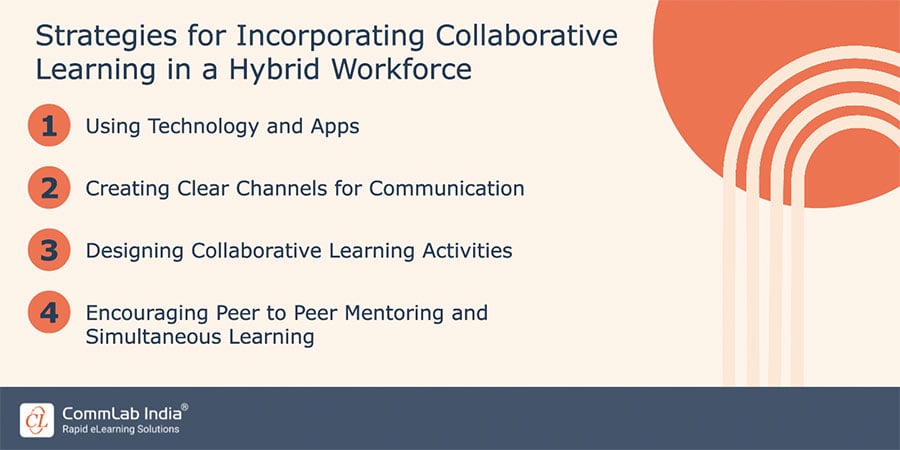Apart yet Together: How to Harness the Power of Collaborative Learning for Hybrid Workforce?
Enhance satisfaction, engagement, and teamwork within geographically dispersed teams, through collaborative learning. This blog will show you how.

The world is rapidly shifting towards new working models. While a significant number of organizations across the globe are opting for a remote workforce, a hybrid workforce – a combination of on-site and remote employees is slowly emerging as the most common working environment. With changes in these working situations, it is imperative for the training managers in every organization to figure out new approaches for employee training and development. To that end, collaborative learning has proven to be a powerful tool in every training manager’s arsenal.
Are You Wondering if Collaborative Learning is the Best Approach for Your Hybrid Workforce?
Take a look at some of its advantages:
- Bridges the gap between on-site and remote employees
- Increases creativity and innovation
- Enhances employee satisfaction levels
- Fosters a sense of teamwork and belonging
Importance of Collaborative Learning in a Hybrid Workforce
Collaborative learning can prove to be a great method to connect any organization’s on-site and remote employees. It offers both types of employees a unique way to share their respective knowledge in order to establish a cohesive and interdependent culture of development in the workplace. It also helps employees, especially the ones working remotely, feel a sense of belonging in their organization.
Through the encouragement of collaborative practices, companies can benefit from a diverse set of skills as well as different perspectives that their employees can offer. This, in turn, can lead to a significant increase in creativity as well as innovation. Furthermore, using collaborative learning techniques also aids in boosting employee satisfaction rates as it fosters a sense of camaraderie and highlights the importance of teamwork.
Benefits of Collaborative Learning in a Hybrid Workforce
Bridging the Gap between On-site and Remote Employees
The key focus of collaborative learning strategies is to offer a platform for both types of employees to come together and exchange ideas and learn and grow together. Using the power of shared learning experiences, that can be facilitated through collaborative projects and assignments, as well as virtual team-building activities, employees can build strong and long-lasting relationships. This can lead to improvements in team bonding, which can ultimately result in increased productivity in respective teams.
Increased Innovation and Creativity
By offering a chance for employees hailing from different educational, operational, and geographical backgrounds, collaborative learning methods facilitate a genuine melting pot for brilliant ideas. Every employee gets a chance to share their own unique vision, and their own take on the training. This can help other employees to understand a subject better, as maybe someone they can relate to can offer more clarity on it. This approach also encourages creativity, as employees can come up with a wide range of solutions to tackle the same problem, offering unseen insights, sometimes even for the trainers.
Enhanced Employee Satisfaction
As this approach heavily relies on the employee’s participation in all training and knowledge transfer sessions, they tend to feel more engaged, as well as valued. Their active participation in these training sessions offers them a sense of accomplishment and ownership over their own views and understanding. This leads to an increase in job satisfaction, and enhancement in employee motivation, and ultimately aids in improving the well-being of both the employees and the organization.
Fostering a Sense of Teamwork and Belonging
In a hybrid workplace, it is very easy for remote workers to feel disconnected from the employees working in the office. This sense of isolation can trigger various types of emotional responses that may interfere with their work, causing a decrease in productivity. Collaborative learning experiences can help a great deal by offering all employees a chance to work together on shared goals and projects that do not have a direct link to their official work output. By working together on a shared project, they can get to know each other well, learn more about their organization, and figure out creative ways to co-exist in a hybrid team.
→ Download eBook: Generating Motivation and Excitement in the Virtual Classroom
Strategies for Incorporating Collaborative Learning in a Hybrid Workforce

Using Technology and Apps
Training managers can leverage various platforms, such as communication and video conferencing software tools, such as Microsoft Teams, or Slack, or Zoom, and project management software tools, such as Asana or Trello to facilitate effortless virtual collaboration. This offers employees and trainers a common ground to share files, co-author presentations or documents, and facilitate real-time communication. Furthermore, using platforms that feature gamification elements as well as interactive learning elements tends to make this collaborative learning experience more satisfying and effective.
Creating Clear Channels for Communication
Establishing clear channels for communication that encourage open and honest dialogue between all employees and trainers is of utmost importance for the successful functioning of a hybrid workforce. It would be helpful if the trainers decide and implement certain clear and pre-determined channels for specific types of communication. Using instant messaging services can help in reducing the mess of back-and-forth communication in the mail inbox. Furthermore, specifying channels for questions, feedback, and peer review can offer employees clarity and encourage them to ask any questions or help each other out without feeling judged or concerned.
Designing Collaborative Learning Activities
Collaborative learning activities should be designed with the sole intention of fostering teamwork and strengthening bonds between the employees. Activities should ideally include various group projects, researching and discussing real-life case studies, and brainstorming sessions. Trainers can also opt for virtual instructor-led training programs that require employees to work together in order to creatively solve various work-related problems. These can help your learners gain knowledge from a subject matter expert in real time and offer them a chance to clear their queries and ask questions, making the training more successful.
Encouraging Peer to Peer Mentoring and Simultaneous Learning
One of the best advantages of the collaborative learning model is the opportunity for the employees to engage in peer-to-peer discussions, reviews, and mentoring sessions. Experienced employees can help new ones and at times, new employees can offer a creative solution to a problem as they have fresh eyes on the issue. Trainers can consider organizing virtual communities or learning circles where employees can share their best practices to tackle a certain issue, learn from each other, and collaborate with each other.
For some more tips and tricks to enhance the quality of your collaborative eLearning sessions, take a gander at this short video.
Common Challenges in Collaborative Learning and How to Counter Them

- Scheduling conflicts can arise when trying to coordinate collaborative activities for employees with different schedules. This can be solved by creating a flexible schedule, one that allows employees to participate according to their schedules. Those with the same schedules can participate together, others can contribute and review the sessions on their own time.
- Trust & rapport building can be difficult when employees have a limited amount of time for face-to-face interactions. This can be solved by organizing fun yet professional team-building exercises, such as virtual lunch or coffee breaks, and various games aimed at getting to know each other better.
- Technological barriers, such as software compatibility and internet connectivity can hamper the effectiveness of these training sessions. This can be solved by ensuring that every employee, remote or on-site, has access to the required hardware and software tools to access these sessions.
Parting Ways
Organizations may overcome the difficulties posed by hybrid work models and promote a culture of cooperation, creativity, and employee satisfaction by prioritizing technology, transparent communication, meaningful activities, and peer-to-peer learning. By embracing collaborative learning, they will experience greater creativity, improved teamwork, and a stronger sense of belonging in addition to bridging the gap between remote and on-site workers. Check out our eBook that can offer creative techniques to get employees excited and motivated about virtual training sessions.




